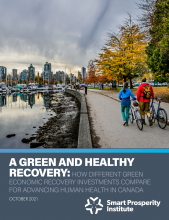In an economic downturn driven by the COVID-19 health crisis, recovery investments that support growth while also improving human health, and environmental outcomes are essential for fostering long-term resilience in line with the objective of building back better.
This report analyses the comparative environmental and health benefits offered by five green recovery projects - energy efficiency retrofits for residential buildings, energy efficiency retrofits for commercial buildings, installing solar or wind generation capacity, getting zero-emissions public transit vehicles on the road, and getting zero-emissions personal vehicles on the road – in three Canadian cities: Calgary, Québec City, and Waterloo-Kitchener.
This comparative assessment focusses on some of the benefits, i.e. the health benefits arising from improvements in air quality from reductions in two pollutants (particulate matter 2.5 (PM2.5), and nitrogen dioxide (NO2 ), and the value gained from reducing greenhouse gas (GHG) emissions, from spending a $100 million sum on five green recovery projects in each city.
The results of the partial cost-benefit screening-level analysis are as follows:
- Residential buildings and transit investments deliver the highest level of average annualized benefits across all three regions. The largest benefit is from GHG reductions, but also high particulate matter reductions, leading to reduced health outcomes.
- Renewable electricity projects in Calgary offer the highest overall level of benefit of any project. These benefits are 8 to 10 times higher than similar investments in Waterloo-Kitchener and Québec City, where electricity is largely decarbonized. This result is a reflection of the grid intensity of electricity in Alberta.
- In all three regions, energy efficiency retrofits for commercial buildings delivered the lowest benefits. This is a function of the high efficiency of commercial boilers and the relatively lower air pollutant emissions intensity per unit of energy, and the lower level of emission reductions that can be attained through deep decarbonisation retrofits relative to other investments.
READ THE REPORT
Read more SPI research on the nexus of health, environment, and economy:
- A green and healthy recovery: How different green economic recovery investments compare for advancing human health in Canada
- The nature of health: integrating health considerations in urban nature-based solutions
- Supporting a Greener Well-Being: Broadening Health in a Green Recovery
- The Health Co-Benefits of a Clean Growth Future
- The Benefits of Cleaner Air



